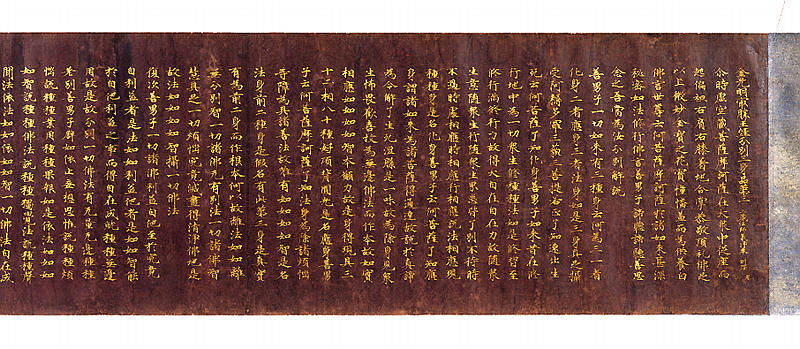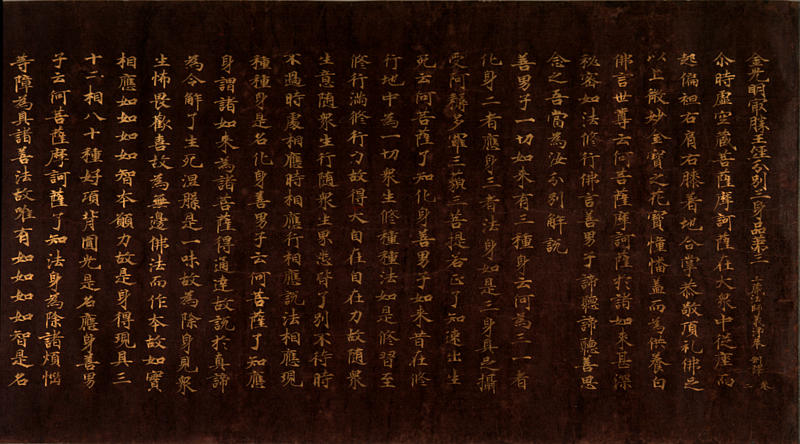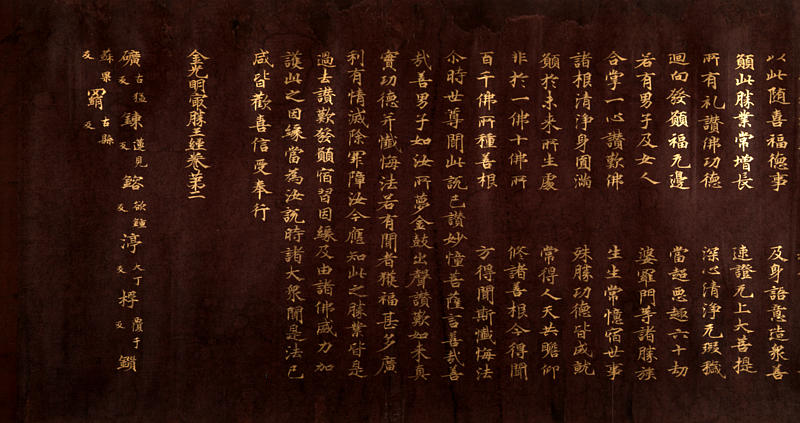紫紙金字金光明最勝王経巻第二
- 奈良
- 奈良時代
- 8c
- 紫紙金字
- H-25.5 W-795.7
- 所蔵
- 重要文化財
紫紙金字金光明最勝王経 巻第二 奈良時代 8世紀 重要文化財 紫紙金泥
天平の昔「全国に国分寺を建てよ。」との天皇の命により、次々と建設される大寺院。瓦屋根など見慣れていなかった当時の人々の目には、田んぼの真ん中に突然高層ビルが立ち上がるような出来事ではなかったろうか。その中に納められる目もあやな金字経。
天平12年聖武天皇の勅を受け、全国の国分寺に納められる「紫紙金字金光明最勝王経」の書写が行われた。この経巻は国家を護る経典として特に能書のものが選ばれたのであろう、金粉を膠に溶かした金泥で文字を書くのは墨書よりもむずかしいが、それと感じ
させない穏やかで均整の取れた文字は、またしなやかな張りをもっており、隋・唐の書を消化した天平写経中の最高峰と言える。
当館所蔵のこの経典は、10巻の金光明最勝王経の第2巻にあたり、紫に染めた麻紙は歳月を経た柔らかい色調を呈している。金はやや赤みがかった温かい色で、盛り上がってはかすれる筆跡は今も燦然と輝いている。
奈良時代 8世紀
紫紙金字
縦:25.5cm 全長:795.7cm
この経典は,唐の義浄が翻訳した『金光明最勝王経』十巻のうちの巻第二の一巻である。天平年間の遒勁な写経体で紫紙に金字で書写されていることから,聖武天皇の勅命により諸国の僧寺(国分寺)に奉安された,いわゆる「国分寺経」の遺品と考えられる一巻である。
『金光明経』は,奈良時代には四天王による国家鎮護の教えが説かれる護国の経典として重んじられ,聖武天皇は神亀2年(725)には僧尼をしてこれを転読せしめ,同5年にもこれを書写せしめ諸国に頒かち,転読を行わせている。これに続いて天平13年(741)には,諸国に僧寺と尼寺を建立せしめる勅を下すのであるが,僧寺の名が「金光明四天王護国之寺」というのは,周知のことであろう。
その書写事業は「写金字経所」で行われ,天平18年(746)までには七十一部七百十巻の「国分寺経」が書写されている。この「写金字経所」には,謹厳かつ遒勁な筆致に見られるよう実に能筆な写経生に加えて,瑩生という従事者がいて書写された金字の経文を
猪の牙で磨いてつやだしを行ったのである。今でも磨いた痕跡を見ることができるが,ここに燦然と美しく輝く文字の秘密がある。
料紙は,古代紫といわれる色の濃い紫紙が用いられており,界線は金界であるが,実に細く鋭い線である。一紙の行数は二十六行,巻末には難解な漢字の字音を表す「音義」が付されている。
この「国分寺経」は,数少ない奈良時代の装飾経の遺品という美術的な美しさは言うに及ばず,歴史的な遺品としても他を凌ぐ逸品と言ってよい。(赤尾)
金光明最勝王経
金光明最勝王経
唐義浄訳。5巻。(大正新修大蔵経16巻 p.335-457)
4世紀頃に曇無讖(ト゛ンムシン)訳の「金光明経」に近いサンスクリット本が成立し、次第に内容を増して義浄訳の原典のようなものが成立したと考えられている。内容は「金光明経」参照。
(「仏典解題事典」水野弘元等編集 春秋社刊 1977より)
金光明経
金光明経
全アジアに広く分布し、チベット語、カルムク語、蒙古語などにも訳されている。刊訳は曇無讖(ト゛ンムシン)訳、陳の真諦訳、後周の闍那崛多(シ゛ャナクッタ)訳、隋の大興善寺宝貴合糅の「合部金光明経」、唐義浄訳の「金光明最勝王経」5巻(大正新修大蔵経16巻 p.335-457)などがある。「合部金光明経」は曇無讖訳の18品、真諦訳の4品、闍那崛多訳2品を釈道安の高弟宝貴が合糅したものという。この他部分的な異訳が5種類つたえられている。
4世紀頃に曇無讖(ト゛ンムシン)訳の「金光明経」に近いサンスクリット本が成立し、次第に内容を増して義浄訳の原典のようなものが成立したと考えられている。内容の重点は寿量本以下の4品におかれ、四方四仏が仏の寿命の長遠なろことを説き、懺悔品、讃歎品では金鼓光明の教えと光明懴(サ゛ン)法の功徳が説かれている。それ以後の諸品では四天王による国家鎮護や現世利的な信仰が説かれている。(「仏典解題事典」水野弘元等編集 春秋社刊 1977より)
国分寺
国分寺
天平13年(741)聖武天皇の発願により、国ごとに置かれた。僧寺と尼寺があり、前者を金光明四天王護国之寺、尼寺を法華滅罪之寺という。律令制と結びつき、鎮護国家、鎮災致福を説く仏教を、中央集権、民衆支配のための精神的な支柱とした。奈良の東大寺はこれらの国分寺を統べる、総国分寺として建立された。
10世紀以後律令制の衰退とともに国家の保護を失い、中世には廃絶した。
伎楽面(迦楼羅)
Catalogue Entry
(s: Suvarna-prabhasotta-ma-raja Sutra),
Scroll 2
Nara period, 8th century
Handscroll, gold paint on purple paper
Height, 25.5cm; overall length, 795.7cm
This sutra is the 2nd scroll of the 10 scrolls of the Konkomyo-Saisho-O-kyo Sutra as translated by I-ching (Gijo) of the Tang dynasty. Brushed in the powerful strokes of sutra script calligraphy of the Tempyo period (729-749) done in gold lettering on purple paper, this scroll is one of the so-called "Kokubunji Sutras" which were placed by Emperor Shomu's decree in the monastic temples built throughout the various regions of Japan (Kokubunji).
The Konkomyo Sutra is honored as the sutra text which protects the nation and teaches that the four guardian gods protect the nation. In 725 (Jinki 2), Emperor Shomu ordered the monks and nuns of Japan to recite this sutra, and in 728 he decreed that this sutra would be transcribed and made available to the various regions of Japan where it would be then chanted. Continuing from these decrees, in 741 (Tempyo 13) the Emperor decreed that monasteries and convents should be built throughout Japan, and these monasteries were to be called "Konkomyo shiten'no gokoku no ji," or loosely translated, the "Konkomyo four guardian god temples to protect the nation."
This sutra transcription project was carried out at the Shakinjikyojo, or "copying gold character sutra office," and by 746 (Tempyo 18), 71 parts of 700 scrolls of the Kokubunji Sutra had been copied. In this Shakinjikyojo, the sutras were copied by talented scribes whose calligraphy was dignified and suitable for such lofty subjects, and other artisans known as Eisei would use flat-bottomed barens to burnish the brushed gold characters. Even today we can see traces of burnishing on the paper, and this burnishing is the secret to the true brilliance and sparkle of the characters.
The paper has been dyed a deep purple color that is known as "antique purple," and gold lines--albeit extremely thin, sharp lines--have been used to set off the text area. A single sheet of paper has 26 lines of characters and an ongi, or pronunciation guide, has been attached at the end of the scroll to give the readings of the difficult characters used in the sutra.
This Kokubunji Sutra set is unsurpassed as one of the few remaining decorated sutras from the Nara period rich in both artistic beauty and historical importance. EA


